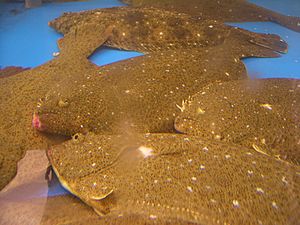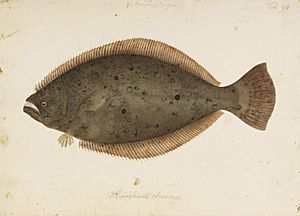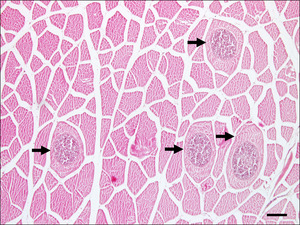Olive flounder facts for kids
Quick facts for kids Olive flounder |
|
|---|---|
 |
|
| Korea flatfish in a supermarket display tank | |
 |
|
| Scientific classification | |
| Synonyms | |
|
Hippoglossus olivaceus Temminck & Schlegel, 1846 |
The olive flounder (Paralichthys olivaceus) is also known as the bastard halibut or Japanese halibut. This fish is a type of large-tooth flounder that lives in the cool waters of the North-western Pacific Ocean.
People often call it the Japanese flatfish or Korean flatfish (광어), especially in those countries. It's considered one of the most valuable fish in the world. Many people like to raise it on fish farms because it grows quickly and is very popular in places like Korea.
Olive flounder can grow quite large. They can reach about 103 cm (40.5 in) in length and weigh up to 9.1 kg (20 lb). Scientists even studied its genome (its complete set of DNA) in 2017 to learn more about how flatfish become flat.
Contents
Where Olive Flounder Live and What They Eat
You can often find olive flounder in soft, muddy areas near the coast, sometimes as deep as 100 m (328 ft). The water in these places is usually between 21 and 24 °C (69 and 75 °F). Some have even been found in the very deep Mariana Trench!
Olive flounder enjoy a varied diet. They typically eat fish eggs, small crustaceans (like shrimp), polychaete worms, and other small fish.
The Olive Flounder's Life Cycle
Olive flounder lay their eggs in shallow water, usually around 70 cm (2.3 ft) deep. This happens anytime from January to August. The eggs and young fish (called larvae) float around for about 24 to 50 days after hatching.
After this time, they start to change shape in a process called metamorphosis. They move to sandy areas and begin to eat shrimp. Once they have fully changed, the young flounder move into deeper offshore waters. There, they start eating bigger fish to grow into their adult size.
How Olive Flounder Become Flat
When olive flounder first hatch, they look like regular fish and swim upright. But after 24 to 50 days, something amazing happens: they turn onto their side! What used to be their side becomes their belly or their back. Also, one of their eyes and a nostril move to the side that is now considered their back. This incredible change is what scientists call "metamorphosis."
Raising Olive Flounder on Farms
The olive flounder is the most common type of flatfish raised on aquaculture farms in Korea. They are also farmed in Japan and China. It's considered the most valuable of the Japanese flounders. Even though people started farming olive flounder in the late 1980s, it wasn't until the 1990s that large-scale farming began in Korea.
A Tiny Guest: The Kudoa Parasite
A tiny, microscopic myxozoan parasite called Kudoa septemlineata was discovered in olive flounder from Korea in 2010. This parasite lives in the muscles of the olive flounder. Scientists have studied this parasite to understand how it affects the fish.
Olive Flounder in Video Games
The olive flounder has even made an appearance in the popular video game series Animal Crossing. Players can try to catch this fish using a fishing rod as one of the many different fish species available in the game.


